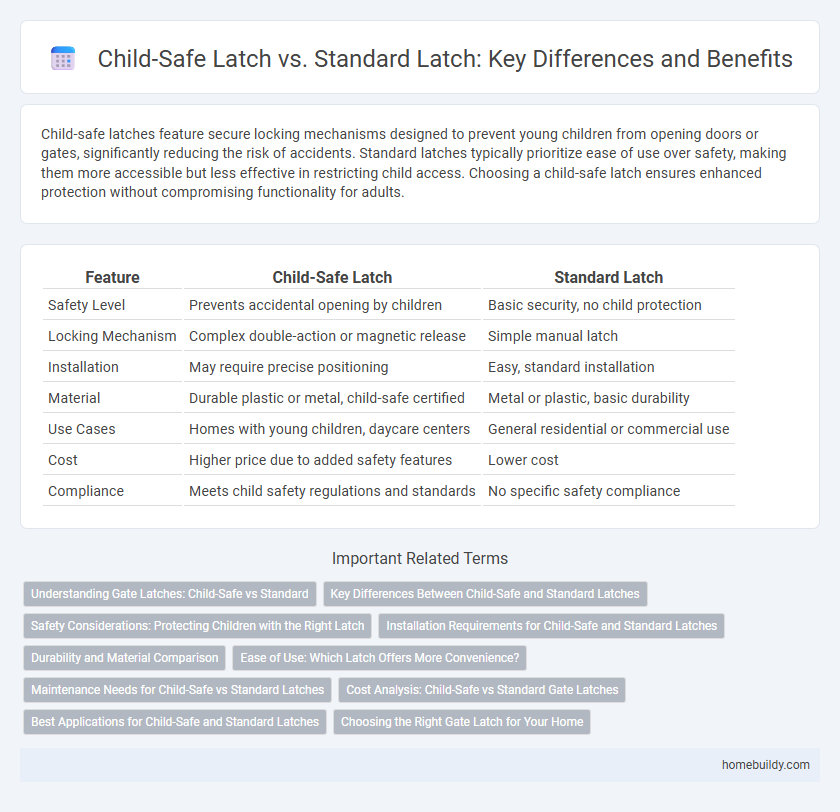Child-safe latches feature secure locking mechanisms designed to prevent young children from opening doors or gates, significantly reducing the risk of accidents. Standard latches typically prioritize ease of use over safety, making them more accessible but less effective in restricting child access. Choosing a child-safe latch ensures enhanced protection without compromising functionality for adults.
Table of Comparison
| Feature | Child-Safe Latch | Standard Latch |
|---|---|---|
| Safety Level | Prevents accidental opening by children | Basic security, no child protection |
| Locking Mechanism | Complex double-action or magnetic release | Simple manual latch |
| Installation | May require precise positioning | Easy, standard installation |
| Material | Durable plastic or metal, child-safe certified | Metal or plastic, basic durability |
| Use Cases | Homes with young children, daycare centers | General residential or commercial use |
| Cost | Higher price due to added safety features | Lower cost |
| Compliance | Meets child safety regulations and standards | No specific safety compliance |
Understanding Gate Latches: Child-Safe vs Standard
Child-safe gate latches feature complex locking mechanisms designed to prevent young children from opening gates, enhancing home safety around stairs or pools. Standard gate latches offer simpler operation with straightforward locking, prioritizing ease of use for adults rather than childproof security. Selecting between child-safe and standard latches depends on the required safety level and accessibility needs in residential or commercial environments.
Key Differences Between Child-Safe and Standard Latches
Child-safe latches feature advanced locking mechanisms designed to prevent children from opening gates, often requiring simultaneous pressure or a specific motion, unlike standard latches that typically operate with a simple lift or slide action. These child-safe latches use materials with enhanced durability and tamper-resistance to ensure long-lasting security in high-traffic areas. Standard latches prioritize ease of use and quick access but lack the additional safety features necessary to protect young children from accidental gate openings.
Safety Considerations: Protecting Children with the Right Latch
Child-safe gate latches feature complex locking mechanisms that prevent accidental opening by young children, significantly reducing the risk of injury or unsafe access. Standard latches, often simpler in design, may be easily manipulated by toddlers, posing potential safety hazards in homes and play areas. Choosing a child-safe latch enhances household safety by ensuring gates remain securely closed, protecting children from dangerous zones such as staircases, pools, or outdoor areas.
Installation Requirements for Child-Safe and Standard Latches
Child-safe gate latches require more precise installation to ensure safety features like complex locking mechanisms or hidden releases are properly aligned and functional, often involving higher placement or added components to prevent child access. Standard latches have simpler installation guidelines, typically requiring basic alignment of the latch and catch, making them quicker and easier to install. Proper measurement and mounting surface evaluation are crucial for both types to maintain gate security and functionality.
Durability and Material Comparison
Child-safe gate latches are typically constructed with high-grade, impact-resistant materials like reinforced nylon or stainless steel to withstand frequent use and prevent accidental opening, offering superior durability compared to standard latches made from basic plastic or lightweight metal. The enhanced design of child-safe latches often includes corrosion-resistant coatings and robust locking mechanisms, ensuring long-term reliability in both indoor and outdoor environments. Standard latches, while functional, usually lack the specialized materials and structural reinforcements that contribute to the extended lifespan and safety compliance found in child-safe models.
Ease of Use: Which Latch Offers More Convenience?
Child-safe latches often feature dual-action mechanisms requiring simultaneous pressure or complex movements, which can reduce convenience compared to standard latches designed for quick single-handed operation. Standard latches prioritize ease of use, allowing adults to open gates swiftly without complicated steps, but they sacrifice childproof security. Therefore, while standard latches offer more user-friendly functionality, child-safe latches balance convenience with enhanced safety features to prevent accidental access by children.
Maintenance Needs for Child-Safe vs Standard Latches
Child-safe latches require more frequent inspections and adjustments to maintain their safety features, such as complex locking mechanisms designed to prevent child access. Standard latches generally have simpler designs, resulting in lower maintenance needs and less frequent repairs. Regular lubrication and component checks are essential for child-safe latches to ensure continued effective performance and avoid failure that could compromise safety.
Cost Analysis: Child-Safe vs Standard Gate Latches
Child-safe gate latches typically cost 20% to 40% more than standard latches due to enhanced safety mechanisms and durable materials designed to prevent accidental openings by children. Installation expenses may also increase by 10% to 15% for child-safe models because of more complex mounting requirements. Despite higher upfront costs, child-safe latches can reduce potential liability and healthcare expenses related to child injuries, offering long-term economic benefits.
Best Applications for Child-Safe and Standard Latches
Child-safe latches are ideal for preventing young children from accessing hazardous areas such as swimming pools, cabinets with cleaning supplies, or staircases, ensuring household safety. Standard latches suit general applications like garden gates, fences, or storage sheds where security and ease of access for adults are primary concerns. Choosing between child-safe and standard latches depends on the need for enhanced safety features versus convenience and regular use.
Choosing the Right Gate Latch for Your Home
Choosing the right gate latch for your home requires evaluating safety features and usability, especially when deciding between a child-safe latch and a standard latch. Child-safe latches are designed with secure locking mechanisms that prevent young children from opening gates, offering enhanced protection around pools, stairways, and yards. In contrast, standard latches prioritize ease of use but may lack the advanced locking features necessary to prevent accidental or unauthorized gate opening, making them less suitable for homes with toddlers.
child-safe latch vs standard latch Infographic

 homebuildy.com
homebuildy.com